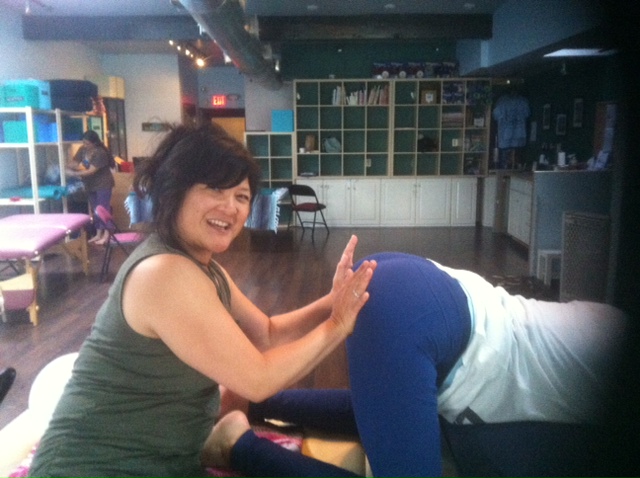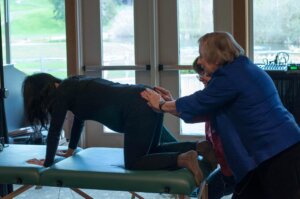
Lisa-Marie Cook, a highly respected labor and delivery nurse in Washington, DC, discovered that pressing back on the pelvis in two areas seemed to help relieve pain and potentially aid rotation.
This clever pain relief technique was first shared with Penny Simkin, a physical therapist. And now, Lisa-Marie herself has given me permission to share it with you!
Sometimes, there is a need to make more room for the baby to descend. Sometimes there is a need for a physical comfort measure by a support person. This technique is an easy way of doing a mild, but often sufficient amount of comfort which adds a little space by softening tight muscles. It’s not really a body balancing technique, it’s counter pressure which soothes the tight pelvic floor from outside the body, even though in rather intimate places on the body.
There may be more pain with baby’s head pressing in the lower portion of the pelvis than the birth giver can breathe through. This technique relaxes the insertion of the pelvic floor in one of two places. (We hope you did Side-lying Release before this pushing phase technique.)
Perhaps the baby, with an asynclitic (tipped) or extended (chin up) head, doesn’t have enough room to come down. A woman with a tight or somewhat smaller pelvic outlet may benefit, as well as a big baby that might appreciate this help to make a little more room.
Lisa-Marie has identified two situations to use counter pressure on the different matching spots.

Versions
Don’t do this technique only if a woman doesn’t want it. Otherwise, I can’t see any reasons why not to.
Dear Gail,
We want to write to you about our recent experience with Lisa-Marie Cook and the Cook Counter Pressure method.
On Monday, October 18, I went into labor at 5am and labored at home until 5pm with my doula. At 5, we left for GW hospital to deliver with our midwife. I was about 7-8 cm dilated. At this point I was in active labor and not progressing much.
To my luck, Lisa was the delivery nurse assigned to us! My goal was to have a natural, drug free delivery. However, by the time I reached the hospital I was asking repeatedly for medication. In addition to the methods my doula was using, Lisa introduced us to specific counter pressure points (sitz bones, pubic arch-pushing, etc.) that provided a lot of relief.
Unfortunately, Lisa’s shift ended before delivery. However, before she left, she was able to teach these methods to my doula who was able to apply them each time I requested them. I would like to emphasize how much relief the counter pressure points provided during the delivery. I ended up having a beautiful, natural birth, but it would not been possible had Lisa not been there to teach our doula these techniques.
Best regards,
Jenny (and baby Anika)
Dear Gail,
I’ve been an avid fan of “Spinning Babies®” for several years. I’ve been teaching many of your methods here at the George Washington University Hospital in Washington, DC to our new Labor and Delivery nurses. We’ve had many successful birth outcomes because of the work you do in the birth world, thank you…
I would love to share a technique that we use here at George Washington University Hospital, and now more on the west coast thanks to Penny Simkin. My work was published in “The Labor Progress Handbook, 3rd Edition” on pages 359-363. Specifically, the “IT” counter pressure points. ( My other counter pressure point helps, but mostly during 2nd stage, doesn’t help with rotation of baby.) It helps by relaxing those pelvic ligaments, helping decrease mom’s perception of pain (especially those with back labor) and often times, between just positioning (hand/knees) and counter pressure, it helps those baby’s to rotate! Ask Penny Simkin, she had a difficult birth that she was a doula at, she used these counter pressure points and that baby delivered beautifully…She’s a believer now and published it to get the word out to doulas and labor support people.
I used it on a laboring patient last week and she said, “This helps so much.” Her doula said, “I’ve never seen that technique before, where did you learn it from?” I told her that I discovered it 6 years ago and it’s been helpful for moms that are stuck or experiencing back labor.
Thank you so much for the work that you do, it is wonderful and inspiring to see how many women have been affected by your website as doulas learn methods to help women birth. I had one of my students tell me that her baby “flipped” from breech after looking at your website…Thanks from all of us.
May your journey continue to be blessed as you touch so many lives.
Respectfully,
Lisa-Marie Cook, RNC-OB, C-EFM, BSN, ICCE, CD
Birthing Basics, LLC
Cook Counter-pressureSM
Thank you, Lisa-Marie, for your care and service to birthing women- in your hospital, and now all around the world!
For additional education to even further enhance your pregnancy and labor preparation, shop our extensive collection of digital downloads, videos, DVDs, workbooks, and more.